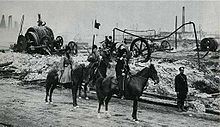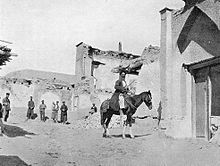This is an old revision of this page, as edited by ArmenianPatriot123 (talk | contribs) at 17:54, 23 May 2007 (→Bibliography). The present address (URL) is a permanent link to this revision, which may differ significantly from the current revision.
Revision as of 17:54, 23 May 2007 by ArmenianPatriot123 (talk | contribs) (→Bibliography)(diff) ← Previous revision | Latest revision (diff) | Newer revision → (diff)


The Armenian-Tatar massacres also known as the Armenian-Tatar war of 1905—1907 refers to the bloody inter-ethnic confrontation between the Azeris (which were then referred to as Azerbaijani or Caucasian Tatars in Russia) and Armenians throughout the Caucasus, then part of Imperial Russia. The events were caused by a lasting hostility between Muslim Tatars on one side and Christian Armenians on the other. They were allegedly incited by the Russian government in order to reinforce its own authority during the revolutionary turmoil of 1905.
The massacres started during the Russian Revolution of 1905, and claimed hundreds of lives. The most violent clashes occurred in 1905 in February in Baku, in May in Nakhchivan, in August in Shusha and in November in Ganja, heavily damaging the cities and the Baku oilfields. Some violence, although of lesser scale, broke out also in Tiflis, but the local Social-Democratic Party, the only force enjoying popular confidence, was able to intervene between the two communities and to prevent larger carnage in the city.
Bibliography
- Stalin: A Critical Survey of Bolshevism at http://www.marxists.org.
- Thomas De Waal (2004), Black Garden: Armenia and Azerbaijan Through Peace and War, NYU Press, ISBN 978-0-8147-1945-9
This Asian history–related article is a stub. You can help Misplaced Pages by expanding it. |
The resistance of the Armenians in Baku is described by Victor Berard in his book: “The attacks against the Armenians in Baku started on February 19, 1905 and turned into downright massacre during February 20-21. The Armenians requested the support of the Russian government, but the local government, which was in collaboration with the Tatars, refused to intervene. So the Armenians of Baku were forced to defend their own destiny. On February 21, the Armenian young men, armed with grenades and rifles which they had hastilygathered, marched towards the streets and quarters which were controlled by armed Tatar bands. The Russian forces, which until that moment refused to intervene and were only spectators of the events, now tried to disarm the Armenians who were thereby forced to fight on two fronts, in other words, to escape being arrested and simultaneously fight the aggressors. Despite this difficult situation, they managed to launch an offensive. At the end of the day, the Tatars were driven away from all the streets around the Armenian church and the city railway station. The following day, the Armenians continued to the other quarters in the city and dispersed all Tatar bands on their way. The acts of vengeance were bloody and Tatar corpses in the streets were increasing in number for each hour that passed. Thus the Tatar leaders turned to the ruler of the city and begged him to put an end to the fighting.”
- Victor Bérard, L'Empire russe et le Tzarisme, Paris, 1905, p. 267 and 268